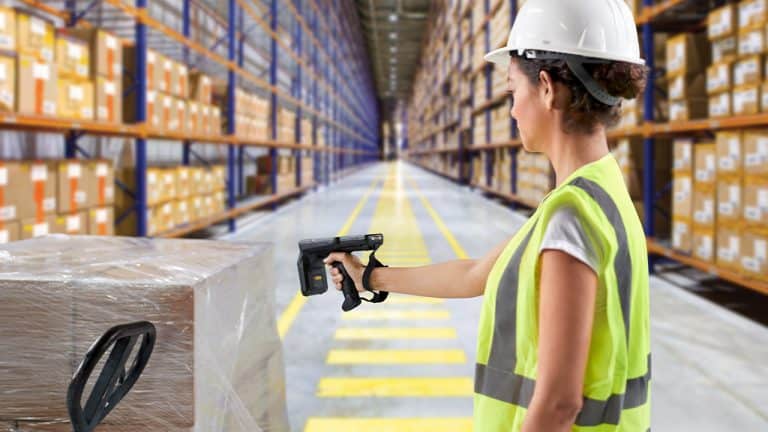RFID Asset Tracking – The Perfect Solution for Asset Management
Table of Contents
In today’s rapidly evolving business landscape, asset management has become more challenging than ever before. All types of businesses, no matter their size, struggle with a host of issues ranging from lost or misplaced assets, inept inventory controls to time-consuming manual processes. These issues costs businesses valuable time and resources and also negatively impacts productivity, operations and profitability.
That’s where RFID asset tracking comes in as a top solution. Radio Frequency Identification (RFID) is a technology that has revolutionised asset management. Its ability to provide real-time information on the location and status of all kinds of assets has been adopted by a wide range of industries, benefiting them greatly.
So, what makes RFID asset tracking software stand out as an innovative and popular system for businesses to use? If you don’t have RFID asset tracking in your business already, by the end of our article, you’ll be convinced.
The Current Asset Management Landscape – Without RFID
Asset management, in its native form, has always been filled with complications and challenges that have affected businesses negatively. Relying solely on these conventional methods creates issues such as:
- Manual tracking errors: Human error is unavoidable, particularly in repeated and monotonous occupations. Manual asset logging and verification frequently result in inaccurate entries, misplaced goods or even loosing assets completely. These mistakes have an impact on daily operations in addition to the bottom line.
- Time-consuming processes: Many manual procedures are used in traditional asset management, such as physical asset counts and data entry onto spreadsheets. These procedures are labour-intensive and slow, which adds to their overall inefficiency and expense.
- Lack of real-time visibility: It is practically impossible to keep an up-to-date inventory of all assets without a system that provides fast updates in real time. This frequently leads to managers reactively making decisions since they are unable to anticipate problems before they arise and deal with them quickly.

The Rise of RFID Technology
RFID asset tracking has become the perfect technology to address the issues of traditional asset management. At its core, RFID technology utilises electromagnetic fields to identify and track tags attached to objects automatically. These asset tracking RFID tags store information that can be passively or actively read from even a few feet away, without the need for direct line-of-site, as is the case with barcodes.
The advantages of RFID technology over traditional methods boast automated accuracy, leading to far less human error as well as practically eliminating the chances of scanning errors on bar codes. Businesses that scale in production and asset management can efficiently use RFID technology in unison with their needs. Whether you’re a small enterprise with a few hundred assets or a multi-national corporation with millions, RFID can cater to all sizes.
What is RFID Asset Tracking?
Businesses whose income depends on the availability of valuable assets are aware of the significance of asset tracking and efficient inventory control, including stock, equipment, IT systems, cars and even workers.
Even if there are several ways to make asset monitoring and tracking easier, RFID is the tracking technology that provides total efficiency in the most economical way. RFID asset tracking is essentially a method of automating the process of managing and finding physical assets. An RFID tag is loaded with data and attached to a key asset. This data could include anything from the asset’s name, its condition, the amount or its location.
An RFID reader can read the data that is stored in an RFID tag by listening for its radio waves, which pulse periodically, ultimately gathering it into an advanced asset tracking system that allows for data monitoring and action. The goal of automating your tracking and monitoring procedures is to eliminate the extremely error-prone practices of using Excel spreadsheets or pen and paper.
Key Benefits of RFID Asset Tracking
Among the many benefits of using RFID asset tracking solutions include:
- Removing human intervention
- Collecting data in real time
- Tracking multiple assets at once
- Improving visibility
- Increasing accuracy of inventory
- Locating lost or misplaced assets
- Saving costs on labour and asset loss

How does RFID Asset Tracking Work?
RFID asset tracking software and hardware, fortunately, works practically the same no matter the industry you’re utilising it in, whether it’s used in a warehouse to track a manufacturer’s supply chain or in agriculture to track livestock.
There are several pieces of sophisticated hardware used for this type of asset management, including:
- Asset tracking RFID tags
- Antenna
- Handheld or fixed RFID readers
- RFID software (can be installed on mobile computers)
It only takes four key steps for the RFID asset tracking procedure to work – once the right equipment is in place. If you need help with finding the right equipment for your business needs, get in touch with the experts at Tec-RFID who can offer you their knowledge.
- An asset is linked to an RFID tag that contains data and has a distinct Electronic Product Code (EPC).
- An antenna detects an RFID tag signal.
- The antenna and an RFID reader are wirelessly connecting, allowing the RFID tag’s data to be read.
- The data is sent by the reader to an asset monitoring database, or the software, where it is kept, assessed, and used.
Overcoming Challenges and Best Practices
While asset tracking with RFID technology is highly beneficial, there may be some challenges businesses face when first trying to implement it.
Integration with your existing system can be a hurdle, ensuring everything works with current operation and IT infrastructures. The best method to overcome this issue is to collaborate with an RFID vendor who offers solutions that can help bridge the gap between systems, ensuring a smooth transition.
Unauthorised data access and breaches are a risk with remote readability, but implementing strong encryption protocols for RFID data can help. Ensure your RFID system adheres to security standards as well as regularly update and patch software to reduce vulnerabilities.
For some employees, the change to RFID asset tracking technology can be daunting, especially those used to traditional methods. Provide comprehensive training regimes that ensure employees are comfortable with the new technology. These can involve hands-on workshops, Q&A sessions as well as training modules to familiarise employees with the tools and software.
Did you know metal, liquids and certain physical environments can interfere with RFID signal and clarity? That’s why it’s important to conduct a site assessment before deploying the tags, readers and other pieces of equipment. RFID assessments can be conducted by the team at Tec-RFID to ensure your technology is successful.

RFID Tracking of Totes and Returnable Containers
Managing reusable totes around your business and customers can be an expensive and time-consuming job. How can you prove that reusable totes are returned from various sites and customers? Do you keep buying totes to replace missing ones?
Container shrinkage of up to 20% annually is quite normal for many businesses. RFID tote tracking could be the answer to this problem, eliminating losses and improving accuracy. Tote tracking using RFID is our most popular implementation this year, where companies are deploying fixed RFID readers at their bay doors to track what goes out and what is returned. By using our RFID asset management software, you get to view the status of pallet returns in real time.
Book a discover call today or get a price on our UHF Tote Tracking Solution by emailing info@tech-rfid.co.uk with the subject:
RFID Tote Tracking Price.
General Queries about RFID Asset Tracking
Yes, RFID can be tracked. This is the primary purpose of the technology – to identify and track items by automatically reading and storing data from tags attached to assets.
RFID (Radio Frequency Identification) tacking is the process of identifying, locating and monitoring items, assets and even living things. RFID tags, which are tiny devices that store data and can transmit data to RFID readers, are used to accomplish this.
RFID tracking has several uses, including tracking equipment in hospitals, tracking livestock on farms, monitoring assets in warehouses and managing inventories in retail establishments.
An RFID tag’s tracking range is determined by its type and operating frequency:
Low-Frequency RFID: Usually reads up to 10 cm away.
High-Frequency: Frequently found in products such as smart cards and hotel key cards, these tags have a one-metre range.
Ultra-High Frequency: Depending on the conditions and the quality of the tag and reader, this type is frequently used for tracking in warehouses and can be ready up to 12 metres away.
Yes, they can as retailers often use these tags for inventory management and loss prevention. However, the tracking range is typically limited to the confines of the store or warehouse if using ultra-high frequency RFID. Once the clothing items leave the store, they will no longer be able to be tracked unless there’s a specific infrastructure to do this.
Also, for privacy, many retailers deactivate or remove these upon purchase.
The possibility of using RFID technology to track stolen items is limited. If an asset embedded with an RFID tag is stolen and the corresponding reader is nearby, it could detect the asset.
However, for more broader scale tracking, such as across a city, RFID is not practical as it requires a dense network of readers, and most have a limited range.
We recommend the Confidex Carrier UHF RFID Label range for this application. These labels are hardwearing and waterproof with a strong adhesive that lasts. Order your labels here. Remember to contact us if you need your labels pre-printed or pre-encoded.

